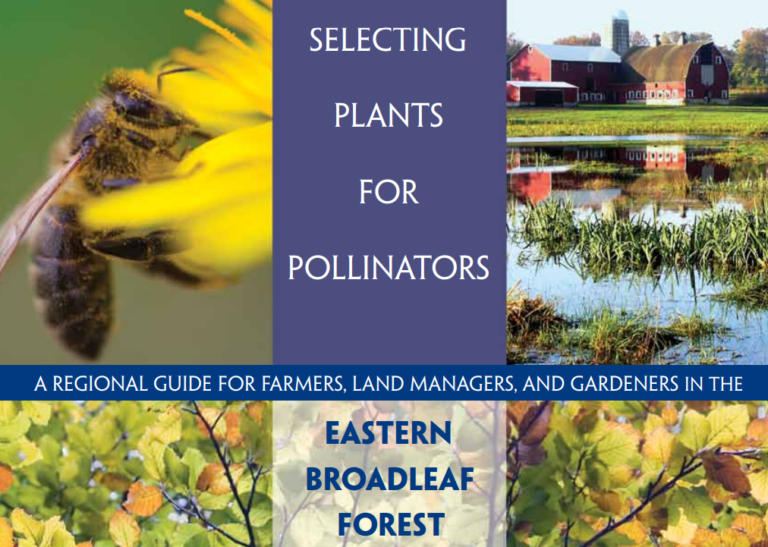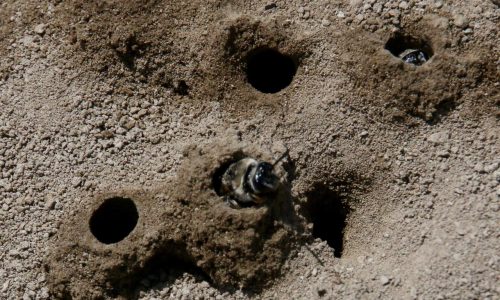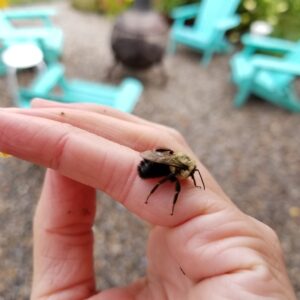Now that we’ve talked about some of the challenges that pollinators are facing, let’s talk about something we can all do to help – creating pollinator habitat.
Whether you have a balcony and a few pots to work with or a farm field, park, or utility corridor, you can help support the flies, bees, butterflies, moths, birds, and beetles. Look for ways to incorporate pollinator habitat when developing for solutions for trouble spots you might have:
- Do you have an area prone to erosion, like along a ditch? Add some pollinator-friendly vegetation to help stabilize the soils.
- Are you working on a road corridor, where the roadway width is oversized? Reclaim some space and add some habitat.
- Do you have space for a hedgerow along a farm field rather than wall to wall crops? Maybe you can add some habitat along a holding pond, or along a non-farmable slope? Can you provide a beneficial cover crop, which also allows you to access your field rather than dealing with muddy, bare off-season soils?
- Can you add plantings under overhead utility lines? Maybe a linear wildflower meadow that you only have to mow once a year?

Pollinator Needs
Exactly what “habitat” looks like varies from species to species. Like us, they need food, a water source, a place to raise their young, and shelter.
Let’s take the monarch, for example. Monarchs are highly specialized when it comes to their host plants. They need milkweed species to lay their eggs on (a “host plant”), as that’s what the caterpillars will eat when they emerge. Similarly, the Painted Lady Butterfly uses hollyhock as its host plant and the Eastern Black Swallowtail relies on parsley, dill, fennel, and rue. However, once they become butterflies, they will need other flowering plants where they can forage for nectar and pollen. Butterflies tend to favor open, flat flowers that offer them a landing pad, like zinnias, cosmos, echinacea, and yarrow.

After the last post, hopefully you’re thinking beyond butterflies and honey bees! Pollinators choose forage plants based on their color, shape, scent or odor, and nectar or pollen production. Not all pollinators are attracted to the same plants, or even the same colors. Here’s what some are drawn to:
- Bees: white, yellow, blue, UV
- Beetles: white, green
- Butterflies: bright red, purple
- Moths: red, purple, pink, white; strong fragrance
- Flower flies: white, yellow, UV
- Filth flies: pale, dark brown, purple; putrid scent

Creating Habitat
When creating a pollinator garden, or any habitat space, start by reviewing what you have and what your goals are. What are you starting with? What needs to be controlled (invasive weeds) versus encouraged (any natives already there)? Observe what parts of your yard pollinators might be using already.
What else do you need? Consider the seasons – aim for support during spring, summer, and fall, and protection during winter. Try to consider plants for forage, vary bloom times, include a water source, and avoid pesticide use.
If you want to help a specific type of pollinator, learn a little about its lifecycle. When does it emerge each season? Select plants that will be blooming, or available as host plants, at that time. Learn about where it nests or overwinters (bare ground? A pile of sticks?), and be sure to include that type of habitat.

Selecting Plants
For the greatest benefits from the plants you choose, priority should be given to native species, then non-invasive non-natives (like ornamental plants). The most effective way to support our native pollinators is to offer plants that evolved with those pollinators. The US Environmental Protection Agency (EPA) has categorized North America into “eco-regions.” The most specific version of these, Level III, is what the Pollinator Partnership uses to develop their Eco-Regional Planting Guides, which can help you identify what plants are native to your local ecology. Many native plants are “easy” — they do not need rich soil or a lot of maintenance. Also check out Native Plants Finder from Homegrown National Park and the Pollinator-Friendly Plant Lists from the Xerces Society.
Try to choose perennials first, then annuals. Planting veggies, herbs, and ornamental plants is okay! Just make sure to avoid invasive species and troublesome weeds. Annuals can be strategic. They grow quickly and, as a result, can crowd out weeds. In the meantime, they offer color, pollen, and nectar as the perennials establish.
Aim for diversity in your habitat space. Vary plant structure (trees, shrubs, herbaceous plants, vines), as well as bloom time. Try to include three different blooms in each season. Many of the early bloomers are trees and shrubs. Fall blooms are critical for both migratory and non-migratory species as they prepare for winter. Also plant multiples of each plant – create a buffet! This helps pollinators get the most benefit and nutrition with the least energy output. You don’t need to plant everything in one spot, though. You can cluster beneficial plants throughout a larger garden or yard.

Getting Native Plants
When you’ve made your list of host plants, pollen and nectar plants, and shelter plants, plan your space according to their preferences. What do the plants need (sun, shade, water levels, soil type)? What does the space need to support them (soil amendments)?
How can you get native plant material? You might want to find “starter plants” for some things and sow seeds for other species. Garden centers near me have begun to carry more and more native species – be sure to ask! Also look for plant swaps and sales, especially as gardeners in your area divide their established plants in spring or fall. If you happen to have a construction project near you, you might be able to ask whether you can “salvage” some plants before they begin demolition. Be sure to check for any local regulations before “collecting” plants or seeds. Also remember to review whether the seeds require any special treatment in order to germinate (cold, heat, moisture, scarification).

Shelter in Habitat Areas
Aside from the food, pollinators need shelter. To provide the right type, we need to know how they live!
Honey bees are unusual in the bee world. They form large, perennial colonies (which we know as hives). They also live over the winter, assuming they find enough pollen and make enough honey. When it comes to foraging for that pollen, honey bees are generalists and may fly long distances to find what they need. Since they form colonies, and have a “home” to defend, they also have barbed stingers.
In contrast to honey bees, most native bees are solitary, meaning they live alone. 70% of native bees nest in the ground, seeking out bare earth or areas of scrubby vegetation. They may also find homes in plant stems, holes in trees, or old wood. Many native bees are short-lived, stay close to home when foraging for food, and are specialists who depend on just a few plant species. They do not store honey or defend colonies, so they are not aggressive.

There is always an exception, of course. Bumblebees are social! They usually nest in cavities, and the Queen emerges in spring to start collecting pollen and nectar to form a colony. Then, the worker bees go out and the queen stays in. Late summer into fall is when reproduction occurs, and only new queens survive over winter.
In your habitat space, try to provide:
- Nesting and overwintering areas
- Bare ground and rock piles
- Hollow stems. It’s okay to cut them down, just leave them in a pile so bees can emerge when the time is right.
- Leaf litter
You might want to offer the stems and leaves, but want to know when it’s okay to “clean up.” If you can’t keep an eye on the patch, wait until temps are, on average, 50ºF/10ºC or more for about a week.
If you’d like to include a bee house, make sure that it can be cleaned out, it’s at least 6 inches deep and holes are about ¼” wide. These size guidelines help protect sheltering bees from predators. Also, make sure it’s not too big! Remember, most native bees are solitary – they don’t like a crowd. Pollinator Partnership has a free guide to show you how to build a homemade Bee Condo.
Questions to ask yourself: In this space, can pollinators find: food? A place to raise their young? Winter shelter? A pesticide-free environment?
When your space is ready, add it to the map at Homegrown National Park!!
Here are some additional resources to keep learning about pollinators:



